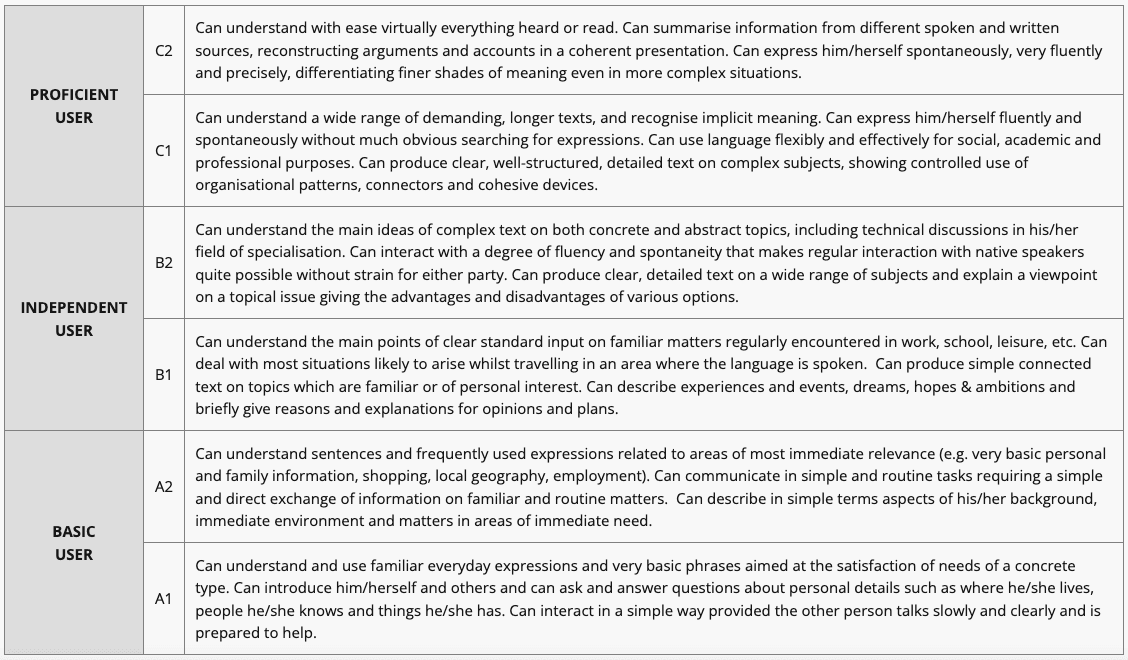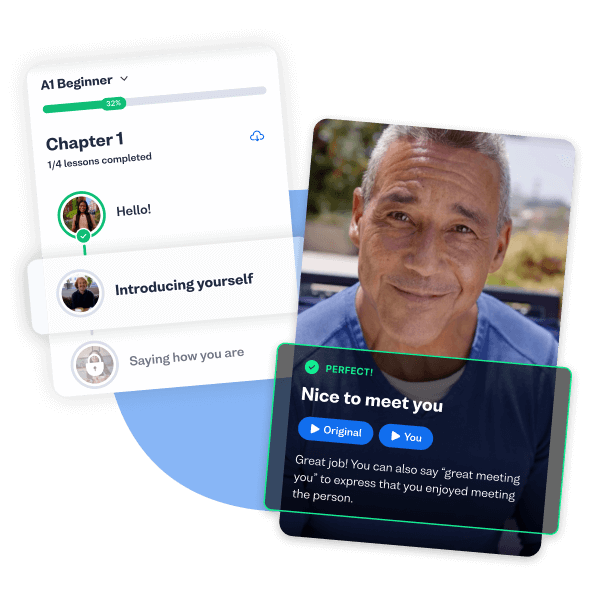I want to learn...
Author:

Barney Meekin
It’s a super common question for language learners to ask: How good am I? Well, luckily you don’t need to guess. The Common European Framework of Reference for Languages (CEFR) can help you figure it out.
In this article, you’ll learn all about the CEFR and how to use it to assess your language skills.
What is CEFR?
The Common European Framework of Reference for Languages (CEFR) is an international scale for assessing language ability. The CEFR is language neutral so you can use it no matter what language you're learning. And it’s easy for both educators and learners to use — to assess someone’s level you just need to check some can-do statements.
For example, if Student A can understand and use only familiar everyday expressions and very basic phrases they are level A1. It can be that simple.
Originally people used the CEFR language proficiency levels to assess European language ability but nowadays people all over the world use the CEFR to assess language skills in any language.
What are the language proficiency levels?
The CEFR breaks language ability down into 6 levels.
The 6 CEFR levels
| Basic user |
|---|
| A1 |
| A2 |
| Independent user |
| B1 |
| B2 |
| Proficient user |
| C1 |
| C2 |
The levels are based on can-do descriptors. Assessing language proficiency is as easy as matching can-do statements to a level. This screenshot from the CEFR’s global scale shows an overview of the 6 levels and the connected can-do statements.

The global scale gives a very brief outline of the levels. And of course, things aren’t as cut and dry as this. Learning a new language involves a bunch of different skills that will develop at their own pace. It’s unrealistic to expect all language learners to fit neatly into these levels. And we don’t recommend you use the global scale to figure out how well you’re doing.
Instead, you should use the CEFR self-assessment grid which is much more detailed and nuanced.
How to assess your language proficiency level
You can easily use the CEFR self-assessment grid to assess your language proficiency. It accounts for differences in the most important language skills so you get a more nuanced picture of your language level.
The self-assessment grid breaks down language proficiency into three categories and a total of five skills. The first category is understanding. The second category is speaking. And the third is writing.
It goes into even more detail for understanding and speaking. Understanding includes the receptive skills of reading and listening. Speaking includes both spoken interaction and production.
Using the self-assessment grid
Here’s how you use the grid to assess your level. The self-assessment grid consists of five rows — one for each skill — and six columns for levels A1 to C2. In each box there is a can-do descriptor. To assess your language proficiency, simply go along each of the five rows and select the can-do descriptor that best matches what you can do. Keep checking off boxes until you hit the correct level.
Let’s take reading for example. If you can read posters full of very simple and familiar language, you’re at (or above) A1. Then go to the next box: A2. If you can read very simple and short texts about everyday topics, you can check this box off. Each box along the row gets more difficult.
At some point you’ll find a can-do descriptor you can’t do. Stop here. The previous box is your level. Let’s say you get to the C1 reading box but you can’t understand specialized and technical instructions. And long, complicated literary texts are impossible for you. This means your level is the previous box: B2.
But it’s not always as clear cut as in this example. It’s perfectly natural that some skills are easier than others for you. For example, if you’ve spent most of your learning time reading, of course, your understanding will be higher than your speaking. There is also likely to be some overlap between the levels. Maybe your listening skills fall between B1 and B2 for example.
All of this is fine. Language learning isn’t always a smooth process so it makes sense that your proficiency might be a bit messy. The CEFR is just a guideline. It’s a useful tool you can use to reflect on your ability and identify areas to improve.
To demonstrate how messy it can look assessing your language proficiency, I’m going to use my Japanese ability as a more realistic example:
Listening: C1
Very rarely can I not understand something I hear. But I struggle with accents (and Japan has a ton of dialects with unique accents and vocabulary) so I’m not C2.
Reading: Between B1 and B2
Reading is an interesting one. I can read complicated texts when they’re related to something I’m interested in. For example, I often read articles about personal finance and business in Japanese (B2). But I struggle reading contemporary literary texts (B2) or technical texts that I have no knowledge of (C2).
In some respects, I’m at B2 level. But in others, I’m not quite reaching B2 level. So I chose between B1 and B2.
Spoken interaction: Between B2 and C1
Speaking is another messy one for me. I can use idioms and colloquialisms (C2) but I often speak with hesitation, searching for expressions (B2). I can use Japanese in personal and professional situations (C1) but without fluency at times.
Spoken production: B2
Because I live in Japan, I speak very casual, everyday language. It’s not often I have to present clear and detailed descriptions of complex subjects. For that reason, I wouldn’t classify myself as C1.
Writing: B1
Writing Japanese is my kryptonite. It doesn’t matter if it’s by hand or by typing, it’s tough for me. It doesn't help that the Japanese writing system is complex.
What this demonstrates is that your levels could be all over the place (and I need to do something about my writing ability!). It’s totally natural for your level not to perfectly fit in the grid. It’s just a guideline. In no way can it account for all the different contexts and situations of language learners. No matter what the grid says, it can never be a 100% accurate representation of your language learning.
But it is a useful way for you to reflect upon your ability and identify areas you need to work on. Just don’t take it too seriously.
AUTHOR

Barney Meekin
Newlanguages


